Atlantic Monthly Contributors's Blog, page 399
July 3, 2015
Empathy: Overrated?
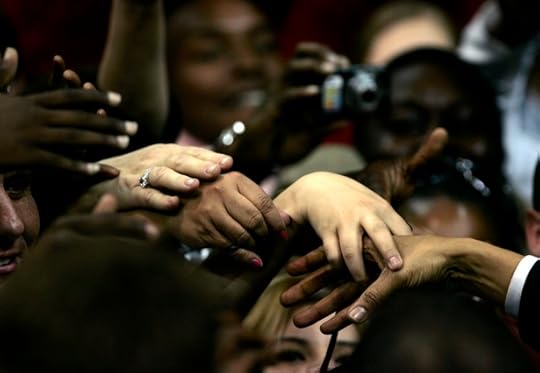
In 2006, then-senator Barack Obama gave a commencement speech offering what seemed like very sensible advice. “There’s a lot of talk in this country about the federal deficit,” he told Northwestern’s graduating class. “But I think we should talk more about our empathy deficit—the ability to put ourselves in someone else’s shoes; to see the world through those who are different from us—the child who’s hungry, the laid-off steelworker, the immigrant woman cleaning your dorm room.”
In the years since then, the country has followed Obama’s counsel, at least when it comes to talking about empathy. It’s become a buzzword, extolled by Arianna Huffington, taught to doctors and cops, and used as a test for politicians. "We are on the cusp of an epic shift,” according to Jeremy Rifkin’s 2010 book The Empathetic Civilization. “The Age of Reason is being eclipsed by the Age of Empathy."
 Dispatches from the Aspen Ideas Festival/Spotlight Health
Dispatches from the Aspen Ideas Festival/Spotlight HealthRead More
Bad idea, say cognitive psychologist Paul Bloom and neuroscientist Richard J. Davidson. At their Aspen Ideas Festival talk on Thursday, Bloom allowed that a the word “empathy” as it’s sometimes colloquially used—to mean kindness, goodness, morality, and love—is unobjectionable. But in the Obama-esque sense of feeling another’s feelings, empathy, they contend, it mostly hurts the world. “To the extent that I’m an empathetic person,” Bloom said, “I’m a worse person.”
Empathy is a documented psychological phenomenon: If you see someone else poked in the hand, Blum said, your own pain centers in the brain will light up. And scientists have demonstrated that you’re more likely to help someone whose pain you feel. The problem, as Blum sees it, is that “because of its focusing properties, [empathy] can be innumerate, parochial, bigoted.” People are often more empathetic toward individuals who resemble themselves, a fact that can exacerbate already-existing social inequalities. And empathy can cause people to choose to embrace smaller goods at the expense of greater ones. "It's because of the zooming effect of empathy that the whole world cares more about a little girl stuck in a well than they do about the possible deaths of millions and millions due to climate change,” Blum said.
Empathy can also make people do evil. “Atrocities are typically motivated by stories of suffering victims—stories of white women assaulted by blacks, stories of German children attacked by Jewish pedophiles," Blum said. It also can lure countries into violent conflicts based on relatively small provocations, and researchers have shown that people who are more empathetic are more likely to want to impose harsh punishments on people. “The more empathy you have, the more violent you are—the more ready and willing you are to cause pain,” Blum said.
“The more empathy you have, the more violent you are—the more ready and willing you are to cause pain.”Empathy doesn’t even necessarily make day-to-day life more pleasant, they contend, citing research that shows a person’s empathy level has little or no correlation with kindness or giving to charity. And in the professions centered around helping others, empathy can be a burden, leading to burnout and incompetence caused by emotional contagion. “When I go to my therapist, I want her to understand me and I want her to make me better,” Blum said. “But if I’m going, ‘I’m anxious and depressed!’ I don’t want her going, ‘I’m anxious and depressed!’”
So what should empathy be replaced with? Blum and Davidson proposed two things. One is “rather cold-blooded, rational cost-benefit analysis,” Blum said. “Go after not what gives you buzz, but what really helps other people." For example: Instead of giving to a child beggar in India, and thereby reward the criminal organization that likely put that child there, donate to Oxfam. The recommendation dovetails with the rising “effective altruism” movement, which The Atlantic’s Derek Thompson recently described as “munificence matched with math.”
Of course, this sounds a lot less emotionally fulfilling than helping someone you have a connection with. That’s where the second potential empathy replacement comes in: compassion. To do good, Blum says, “we need an emotional push. But the push need not come from empathy. It can come from love, from caring, from compassion, from more distant emotions that don't come from being swallowed up in the suffering of others."
At the University of Wisconsin, Madison, Davidson has studied the brains of Buddhist monks and explored the ways that compassion is neurologically distinct from empathy. He even believes it to be an intrinsic trait like linguistic ability—something that must be fostered at a young age to be implemented throughout life, and something that can be strengthened through practice. To that end, he and his colleagues developed a “kindness curriculum” for preschoolers.
But what about personal relationships—don’t they rely on empathy? Blum and Davidson said it’s possible but not yet scientifically proven that some amount of empathy is indeed required in order to practice compassion. But they contend that even the closest relationships need not be dominated by the sharing of emotions. At the end of the Aspen session, an audience member posed a scenario to the scientists: What if she was fired from her job, and her partner offered her a back rub and kind words but didn’t truly get why she was upset? Wouldn’t the comfort feel hollow, useless?
“What you’re really asking for is compassion plus understanding,” Blum replied. “Suppose you feel humiliated. I don’t think it’s what you want or what you need for your partner to feel humiliated. You want your partner to understand your humiliation and respond with love and kindness. I think for your partner to feel humiliated would be the worst thing you want. Because now, you have to worry about your partner’s feelings.”









Do Horoscopes All Say the Same Thing?

Here’s my horoscope for July 3, 2015, according to Full-sized image here. (David McCandless/informationisbeautiful.net)  Dispatches from the Aspen Ideas Festival/Spotlight Health
Dispatches from the Aspen Ideas Festival/Spotlight Health
Read More
There are exceptions to the overlaps, though. The words in red are the unique ones that appeared in the top 50 words for each sign. “Charm” stands out in Leo horoscopes; it will surprise none of my friends or coworkers to learn that “talking” is unique to my astrological sign.
In presenting these findings, McCandless also used what he learned to make a meta-prediction of what your average horoscope might say on any given day in the future. So whether you’re a Pisces on November 11, 2015, or a Libra on February 2, 2525, this one’s for you:
Whatever the situation or secret moment, enjoy everything a lot. Family and friends matter. Keep making love. The world is life, fun, and energy. Maybe hard. Or easy. Change your mind and a better move comes along.
And I guess taxes are important, too.









Hunger Games: The Uncertain Future of Competitive Eating

On Saturday, Joey “Jaws” Chestnut will attempt to defend his title in the Nathan’s Famous Fourth of July Hot Dog Eating Contest. He’ll probably win, and if he does it’ll be his ninth straight victory—a feat of longevity rarely seen in any athletic competition. Despite being pushed hard by last year’s runner-up in the annual contest, Chestnut’s total of 61 hot dogs consumed was still notably better than the second-place contestant’s 56. By all accounts, Chestnut is the best in the world at what he does.
Related Story
The High Art of Competitive Eating
But his success in the contest masks a problem—he’s been so dominant for so long in Major League Eating’s flagship event that the sport has failed to give rise to a successor. MLE is synonymous with the Nathan’s contest, and the Nathan’s contest is Chestnut’s turf. Ironically, the sport that rewards competitors for focusing on a single food in any given contest may well be undone by its own myopic focus on Chestnut on the Fourth of July.
As Chestnut enters his early 30s, an age when most athletes start to decline, he’s easier to beat. But his vulnerability is a function of him regressing to the level of his competitors rather than rising up to meet a challenge, and that’s a problem. In a non-team sport, fans have to root for an individual, and that’s easier to do if there’s a viable challenger. Debating which of two athletes at their best is better is a time-honored and successful tradition, but promoting a formerly great athlete competing at almost as high a level relative to their peak? That’s a great way to alienate fans.
Putting aside the question of whether competitive eating is actually a “sport,” let’s at least acknowledge that there’s a significant physical component to it. Competitors have to train their bodies to quickly consume—and keep down—numerous pounds of meat and nitrites (“reversals of fortune” are grounds for disqualification). If the last 35 years of competition are any indication, there are significant limits to human physiology when it comes to eating hot dogs.
As in any competition, upgrades in technology or technique can greatly influence outcomes, but once those optimizations are at their peak, there’s precious little wiggle room. When an athlete competes at the highest level in a mature sport, the distance between the best and worst competitor is diminishingly small. It’s why “Any Given Sunday”—the principle that the talent gap between teams in the NFL is so small that even the worst team can defeat the best in a single game—is a football axiom, but also why the worst NFL team would easily defeat the best college team.
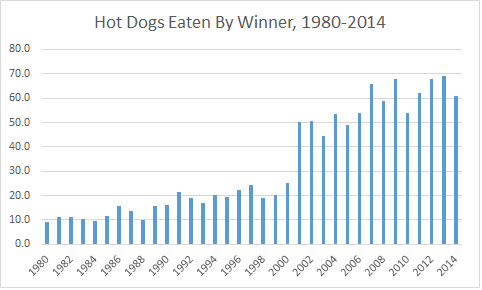
This holds true for competitive eating, too. Prior to Takeru Kobayashi’s arrival on the scene in 2001, an eater could consume a couple of dozen hot dogs and have a chance at the championship. With Kobayashi, the 21st-century version of the contest became more of a science. Tactics such as separating the buns from the franks to increase efficiency and using liquid to soften the buns and hasten consumption saw wider acceptance. Having final totals in the range of 50 dogs might have guaranteed victory a decade ago, but that’s barely good enough for third place these days.
There’s no eating tactic that can yield the significant increases in efficiency witnessed at the turn of the century. When Chestnut defeated Matt Stonie 61-56 in last year’s contest, it was a simple matter of athletic prowess—yet it’s a difference of less than 10 percent, a far cry from the nearly 100 percent difference between the 2000 and 2001 winning totals.
Unfortunately for Chestnut, athletic prowess tends not to age well—especially in competitions requiring quick bursts of strength. Look at the major sports: Very few professional athletes are 35 or older because they simply can’t maintain the level of performance they had even a few years prior. It’s why so few long-term, free-agent contracts work out well for a team. They pay players for performance now, despite the fact that players won’t be able to maintain that level of excellence into their late 30s.
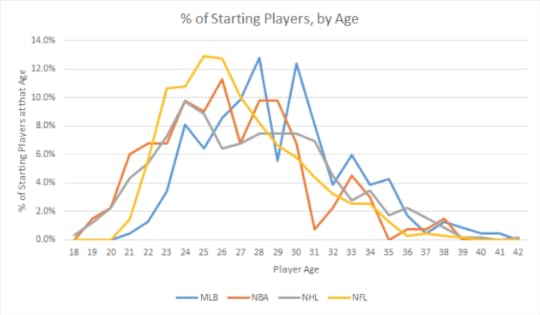 Data from most recent completed season in each sport. A player is considered a starter if they started at least 50% of their team’s games that season. Source: Sports Reference
Data from most recent completed season in each sport. A player is considered a starter if they started at least 50% of their team’s games that season. Source: Sports Reference Older competitors tend to fare better in endurance-based competitions such as marathons. Yet Chestnut’s not running 26 miles—he only performs for a rapid-fire period of 10 minutes, often in grueling heat. And he’s only 31, so he’s still probably on the right side of a competitive eating age-versus-performance curve. But he’s highly unlikely to get any better, meaning he may never break his own record of 69 hot dogs. And so before Chestnut falls off that curve and into his decline phase, MLE needs to cultivate a deeper bench of top performers or develop a series of other competitions to garner wider attention among viewers.
Consider that Chestnut is by far the most famous athlete under the MLE fold. Then consider his nearest competitors in recent years: Tim Janus, Matt Stonie and Patrick Bertoletti. Two of them are virtually unknown, and Stonie barely registers interest relative to the juggernaut that is Chestnut. The only competitive eater who comes even close to Chestnut’s fame is Kobayashi himself: a man who’s been banned from competition since 2010 and who’s also 37 years old. Even if Kobayashi and MLE mended fences, the sport would be welcoming back a competitor who’s past his prime, not planning for the future like it should be.
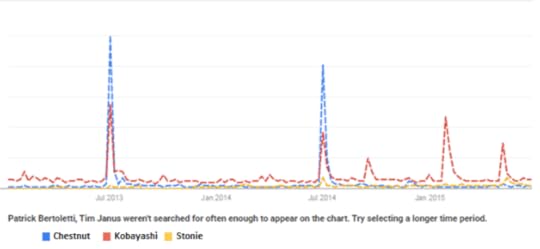 Ranks are relative to one another, not absolute. Source: Google Trends
Ranks are relative to one another, not absolute. Source: Google Trends The MLE could probably work around its lack of a Chestnut successor if it had a signature event besides the July 4 hot dog contest. The Nathan’s contest is to other MLE events as Chestnut is to other MLE eaters: It dwarfs them to the point of irrelevance. You need look no further than MLE’s own website to get a sense of how upcoming events are rated. Not only is the prize pool for the Nathan’s contest the largest, but it’s orders of magnitude larger than most other events. Only the Hooters Worldwide Wing Eating Championship (which Chestnut also wins) comes close in terms of prize money, but at barely half the purse.
There’s no comparison when it comes to media coverage, either. In recent years, the Nathan’s contest has been aired on an ESPN network, though in what should be a worrying sign for MLE, the only way in previous years to view the contest live has been on the web-only ESPN3. The television channels have taken to airing the event on tape delay. (This isn’t the case this year, though: ESPN2 will broadcast the men’s competition live even as the women’s competition is web-only.) Regardless, you’d be hard-pressed to find another competitive eating-event with any national coverage, to say nothing of coverage on a major carrier.
The MLE executive George Shea—the same man who gives the over-the-top intros at the Nathan’s contest—would be well-served to create a mystique around another eater or another event. To be sure, this is a difficult endeavor: The narratives for Kobayashi and Chestnut all but wrote themselves. The Japanese Kobayashi demolishing the previous record in an event held on Independence Day was the MLE equivalent of Sadaharu Oh joining the Yankees and hitting 120 home runs to leave Roger Maris and Babe Ruth in the dust. Which made the story of Chestnut, an American, reclaiming the title all the more alluring. During the brief period where Kobayashi and Chestnut competed head-to-head, MLE had a rivalry storyline to fall back on. There’s no such obvious narrative for a Chestnut successor, and with age starting to factor into the equation, perhaps the best MLE can hope for is a situation akin to the final movie in the Rocky series.
Regardless, Shea has his work cut out for him if he wants to ever have MLE approach mainstream sensibilities and be accepted as a sport rather than a showcase for freakishly dominant athletes. Joey Chestnut may well be the best competitive eater of all time, but that won’t matter in the relatively near future. All athletes peak and decline with age, and to put all of MLE’s eggs in the Chestnut basket is a recipe for MLE’s own reversal of fortune.









Michael Eisner to Goldie Hawn: Most Beautiful Women Can't Be Funny

Midway through Goldie Hawn and Michael Eisner’s on-stage conversation at the Aspen Ideas Festival on Thursday, the former Disney CEO proposed a theory for what made Hawn stand out in Hollywood over the years.
“From my position, the hardest artist to find is a beautiful, funny woman,” he said. “By far. They usually—boy am I going to get in trouble, I know this goes online—but usually, unbelievably beautiful women, you being an exception, are not funny.”
It’s a statement that recalls Christopher Hitchens’s Vanity Fair essay, “Why Aren’t Women Funny?,” which drew big controversy upon its publication in 2007, given the success of women comedians from Lucille Ball to Tina Fey. For her part, Hawn said she agreed that she may owe her sense of humor to her being an “ugly duckling” growing up.
 Dispatches from the Aspen Ideas Festival/Spotlight Health
Dispatches from the Aspen Ideas Festival/Spotlight HealthRead More
“You didn’t think you were beautiful,” Eisner said. “I know women who have been told they're beautiful, they win Miss Arkansas, they don't ever have to get attention other than with their looks. So they don't tell a joke. In the history of the motion-picture business, the number of beautiful, really beautiful women—a Lucille Ball—that are funny, is impossible to find.”
Earlier in the wide-ranging discussion of Hawn’s career and current charity efforts, Eisner had asked her about Hollywood sexism. She’d worked in can-can routines and even danced in cages in her early days, and the men who watched her were just as “disgusting” as you’d expect.
“I, by the way, for the record, never in 40 years was I ever offered a bribe, a favor, a date, or anything,” Eisner said. “To me, I never saw any of that. But that exists in our world, where you go for an interview and people have other ideas, or is that just a fantasy?”
“They don't ever have to get attention other than with their looks. So they don't tell a joke.”Hawn looked a little surprised. “You don’t know my story?”
She then launched into a seven-minute anecdote of meeting with the humorist Al Capp to discuss her playing a part in a production he was involved in. Capp, Hawn said, propositioned her and exposed himself to her; later, the man who’d set up the meeting confessed to being Capp’s “pimp.”
“So when you ask about that,” she said at the end of the story, “the answer is yes.”
In recent years, Hawn established the Hawn Foundation, which seeks to teach children about how to free themselves from distraction, anger, and fear by practicing breath control and meditation in the classroom. She and her foundation assembled neuroscientists, educators, psychologists, and mindfulness experts to come up with a curriculum called “MindUP.” Hawn said that she was inspired to work for this cause in part by the realization that young people in a post-9/11, Internet-addicted world face more uncertainty and negative stimuli than they may have before. She was also motivated by a desire to move away from acting given that the industry offers fewer roles to women as they get older.
“When you get to a certain age, you have to make a decision for yourself,” Hawn said after an audience member asked about ageism in Hollywood. “If you want to get old in the industry and you want to play maybe a few parts that come along now and then—or what else in life interests you?"
Eisner chimed in to point out that both he and Hawn were able to find success at an early age—she as an actress at age 18, he as president of Paramount in his 30s. “I'm very happy that in this country you don't have to be 72 before someone recognizes you, as in some other countries,” he said. “I'm very happy that swimmers peak at 14 or 18. It's okay."









The Small-Town, Big-Hearted Appeal of Back to the Future
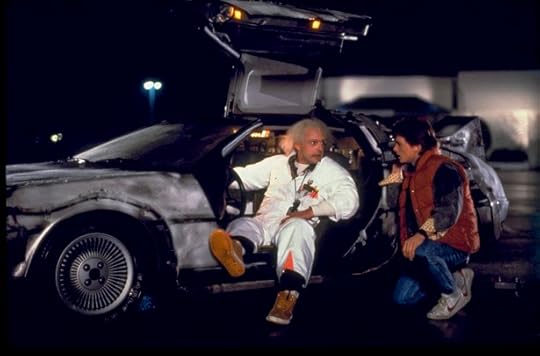
Thirty years ago, the blockbuster release for the July 4th weekend was a film about a young man trying to rescue his parents’ marriage. Yes, Back to the Future involves time travel, special effects, and some dizzyingly creative science-fiction plotting, but the story at its core is a simple one, and its stakes are appreciably low. Just as Jaws ignited a box-office revolution ten years previously as a tale of three men in a boat after one shark, Back to the Future was a genre-defining hit in 1985, spending 11 weeks at number one and spawning two sequels—all without resorting to over-budgeted theatrics.
Related Story
1985: The Last Great Year in Film for Young Audiences
Strip away the time-travel facade and Back to the Future is a fun, zany small-town comedy, with its nastiest villain a high school bully and its biggest triumph a kiss between his two victims. Director Robert Zemeckis seized upon the concept of Marty McFly’s DeLorean trip to 1955 while looking through his parents’ basement and stumbling upon relics from their graduating class. He pitched the idea to Steven Spielberg, who agreed to produce the project. The strength of the movie is that its most fantastical element is rendered as something any audience member could imagine: the bizarre and frightening experience of meeting your parents as their teenaged selves. Compared to the current era of summer movies, so focused on omnipotent superheroes doing battle on a planetary scale, that simplicity feels revolutionary.
It also serves to disguise Back to the Future’s more absurd plot details. The movie’s hero, Marty (Michael J. Fox) is a teenager refreshingly free of angst. He’s in a band, he has a cool girlfriend, and his best friend is the middle-aged scientist Doc (Christopher Lloyd), who lives on the outskirts of town and has stolen some plutonium from a group of Libyan terrorists. It says everything about the breeziness of the script (from Zemeckis and Bob Gale) that these revelations (Marty and Doc’s May-December friendship, the shocking and violent appearance of the Libyans) have an air of plausibility.
In another actor’s hands, Marty’s friendship with Doc might come off as a symptom of extreme teenage disaffection, but Fox’s nice-guy charm smoothes things over without much fuss. Zemeckis notoriously filmed weeks of footage with a different lead, Eric Stoltz, who gave the role a much darker, method acting-infused spin, before firing and replacing him with Fox, his original first choice. The then-23-year-old was best known as a sitcom star in NBC’s Family Ties, and with those multi-camera acting chops came the ‘50s vibe Zemeckis wanted. When Marty picks up a guitar and plays a Chuck Berry riff perfectly, it just makes sense—he feels cut from the cloth of that era of post-war American exceptionalism where anything was possible.
The similarities in scope between Back to the Future and Jaws aren’t coincidental—Spielberg directed Jaws and played a major role shepherding Zemeckis’ vision to the screen. Back to the Future was a salve for the darker, edgier, early ‘80s era in Hollywood—Spielberg had misfired with the excessively gory Indiana Jones and the Temple of Doom in 1984, a year that also featured gritty R-rated box office hits like The Terminator and Beverly Hills Cop. In 1985, the top box office films were flag-waving tales of American glory like Rambo: First Blood Part II and Rocky IV, along with heartwarming throwback films like Cocoon and The Goonies. But Back to the Future topped them all, literally traveling back in time to tap into America’s small-town ‘50s nostalgia.
Back to the Future literally traveled back in time to tap into America’s small-town ‘50s nostalgia.Once Marty arrives in the past, all he really needs to do is ensure that his parents (played by Crispin Glover and Lea Thompson) get married, perhaps with a little help from the band at their high school dance, while avoiding the evil antics of local bully Biff (Tom Wilson). Yes, Marty might just end up inventing rock and roll as a result (the phone call to Chuck Berry is such a hilariously false note it’s hard not to laugh) but that’s just one of Zemeckis and Gale’s clever little details. Time-travel fiction is notoriously hard to write without getting overly buried in complexity: Back to the Future remains the gold standard for keeping its logic in check throughout Marty’s trip to 1955 and back.
This July 4th weekend, another time-travel franchise is getting rebooted for the umpeenth time. Terminator Genisys dips deep into temporal vagaries to justify a film that recasts all of its leads except for Arnold Schwarzenegger, while still explaining how he’s aged 31 years since the original entry it’s aping. It’s utter nonsense, and worse than that, it spends too much time tying itself in narrative knots trying to explain its existence to have anything left over for its characters. Time travel is a worrying element for any sci-fi franchise a studio might want to hungrily reboot, and Back to the Future feels especially vulnerable—the DeLorean is sitting right there, after all.
Fear not. Robert Zemeckis promises such a reboot will literally happen over his dead body, saying, “We’ve seen a lot of sequels that are made years and years later and I don’t think I can name one that’s any good.” It’s a lesson Hollywood still needs to learn, and Back to the Future teaches it well. Forget established brands or CGI-laden setpieces. Invest in your characters, keep the stakes realistic, and have your happy ending feel hard-earned—even if it’s as insignificant as a kiss at the school dance and a successful drive home.









July 2, 2015
The 2016 U.S. Presidential Race: A Cheat Sheet

In a different era’s Democratic Party, Jim Webb might be a serious contender for the presidential nomination. He’s a war hero and former Navy secretary, but he has been an outspoken opponent of recent military interventions. He’s a former senator from Virginia, a purple state. He has a strong populist streak, could appeal to working-class white voters, and might even have crossover appeal from his days as a member of the Reagan administration.
In today’s leftward drifting Democratic Party, however, it’s hard to see Webb—who declared his candidacy Thursday—getting very far. As surprising as Bernie Sanders’s rise in the polls has been, he looks more like the Democratic base than Webb does. The Virginian is progressive on a few major issues, including the military and campaign spending, but he’s far to the center or even right on others: He's against affirmative action, supports gun rights, and is a defender of coal. During the George W. Bush administration, Democrats loved to have him as a foil to the White House. It’s hard to imagine the national electorate will cotton to him in the same way. Webb’s statement essentially saying he had no problem with the Confederate battle flag flying in places like the grounds of the South Carolina capitol may have been the final straw. (At 69, he’s also older than Hillary Clinton, whose age has been a topic of debate, though still younger than Bernie Sanders or Joe Biden.)
In fact, it looked a little like Webb might not even run late this month. He is unlikely to raise much money, has never shown a great deal of relish for the drudge work of politics, and isn’t deluded about the stiff odds he faces. But he’s a man with strong beliefs, and he launched his campaign with a detailed set of issue positions on his website. Even though Webb will probably never make it anywhere near the presidency—he sits at just 2.3 percent in RealClearPolitics’s average, though that’s still good enough to edge poor Martin O’Malley—his entrance might add some spice to the Democratic primary.
With so many candidates in the mix—some announced, some soon to announce, and some still on the fence—it’s tough to keep track of it all. To help out with that, this cheat sheet on the state of the presidential field will be periodically updated throughout the campaign season. Here's how things look right now.
* * *
The Democrats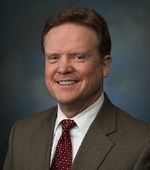 Wikimedia
Wikimedia Jim Webb
Who is he? Webb is a Vietnam War hero and secretary of the Navy. The author of several books, he served as a senator from Virginia from 2007 to 2013.
Is he running? Yes, as of July 2.
Who wants him to run? Dovish Democrats; socially conservative, economically populist Democrats; the Anybody-But-Hillary camp.
Can he win the nomination? Probably not. While Webb was the perfect candidate for Senate from Virginia in 2006, his statement in support of the Confederate flag shows why he probably has little hope in the national Democratic Party.
What else do we know? Read Webb’s longtime friend James Fallows on why he wants Webb in the race.
Does his website have a good 404 page? No.
 Wikimedia
Wikimedia Hillary Clinton
Who is she? As if we have to tell you, but: She’s a trained attorney; former secretary of State in the Obama administration; former senator from New York; and former first lady.
Is she running? Yes.
Who wants her to run? Most of the Democratic Party.
Can she win the nomination? Duh.
What else do we know? Maybe a better question, after so many years with Clinton on the national scene, is what we don't know. Here are 10 central questions to ask about the Hillary Clinton campaign.
Does her website have a good 404 page? If you’re tolerant of bad puns and ’90s ’80s outfits, the answer is yes.
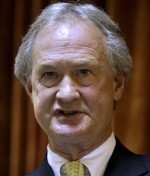 Steven Senne / AP
Steven Senne / AP Lincoln Chafee
Who is he? The son of beloved Rhode Island politician John Chafee, Linc took his late father’s seat in the U.S. Senate, serving as a Republican. He was governor, first as an independent and then as a Democrat.
Is he running? Yes—he announced his run at George Mason University on June 3.
Who wants him to run? Beyond metric-system boosters? No one knows! Even in Rhode Island, Chafee doesn’t have much support—he opted not to seek reelection as governor in 2014, in part because his approval rating had reached a dismal 26 percent.
Can he win the nomination? No. Chafee seems to be positioning himself as an economic populist and says Clinton's 2002 vote for the Iraq war should disqualify her (he was the only Republican senator to vote against it). In other words: He's Jim Webb with a less impressive resume, a less compelling bio (he's the son of longtime Senator John Chafee), and less of a political base. He gives himself even odds, though.
Does his website have a good 404 page? No.
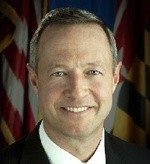 Wikimedia
Wikimedia Martin O'Malley
Who is he? He’s a former governor of Maryland and mayor of Baltimore.
Is he running? Yes. He announced his campaign on May 30.
Who wants him to run? Not clear. He has some of the leftism of Bernie Sanders or Elizabeth Warren, but without the same grassroots excitement.
Can he win the nomination? At the moment, O’Malley seems caught between Sanders, who has grasped the progressive mantle, and Clinton, who dominates the Democratic race overall. As with Sanders, though, it’s hard to see where O'Malley would get an opening unless Clinton’s campaign fell apart. The conventional wisdom since protests over the death of Freddie Gray is that protests in Baltimore undermine the case for his candidacy and make it harder for him to run, but he’s embraced the protests as a motivation for his run.
What else do we know? Have you heard that he plays in a Celtic rock band? You have? Oh.
Does his website have a good 404 page? No.
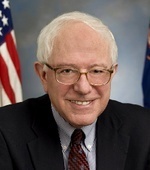 Wikimedia
Wikimedia Bernie Sanders
Who is he? A self-professed socialist, Sanders represented Vermont in the U.S. House from 1991 to 2007, when he won a seat in the Senate.
Is he running? Yes. He announced April 30.
Who wants him to run? Far-left Democrats; socialists; Brooklyn-accent aficionados.
Can he win the nomination? It remains extremely difficult to see him winning the nomination, on the basis that primary voters tend to gravitate to “electable” general-election candidates alone. But he’s proven an ability to poll well into double digits, and he has a fired-up grassroots base. If nothing else, his campaign seems to be succeeding in getting his progressive ideas into the mix.
Does his website have a good 404 page? Yes, and it is quintessentially Sanders.
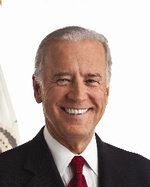 Wikimedia
Wikimedia Joe Biden
Who is he? Biden, a longtime Delaware senator, is vice president and the foremost American advocate for aviator sunglasses and passenger rail.
Is he running? He's made no serious steps toward a run, but whispers have grown since the death of his son Beau Biden in May. The Biden family hadn’t publicly noted that Beau Biden was ill, but his father’s time seems to have been absorbed with caring for him.
Who wants him to run? The Wall Street Journal reports that both Beau Biden and his brother Hunter encouraged their father to run. The group Draft Biden (slogan: “I’m Ridin’ With Biden”) continues to do its best. But so far, the vice president has made few steps that would suggest a real campaign.
Can he win the nomination? If Clinton didn't run, it would throw the Democratic field into disarray. But probably not. At 72, Biden would also be an unusually elderly candidate.
When will he announce? It seems likely that he won't.
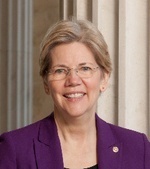 Wikimedia
Wikimedia Elizabeth Warren
Who is she? Warren has taken an improbable path from Oklahoma, to Harvard Law School, to progressive heartthrob, to Massachusetts senator.
Is she running? No. Seriously, no.
Who wants her to run? Progressive Democrats; economic populists, disaffected Obamans, disaffected Bushites.
Can she win the nomination? No, because she's not running.
* * *
The Republicans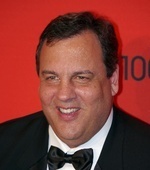 David Shankbone
David Shankbone Chris Christie
Who is he? What’s it to you, buddy? The combative New Jerseyan is in his second term as governor and previously served as a U.S. attorney.
Is he running? Christie kicks off his campaign June 30 at Livingston High School, his alma mater.
Who wants him to run? Moderate and establishment Republicans who don't like Bush or Romney; big businessmen, led by Home Depot founder Ken Langone.
Can he win the nomination? The tide of opinion had turned against Christie even before the "Bridgegate" indictments. It's hard to imagine how he recovers at this point, given the crowded field and the fact that Jeb Bush seems to dominate the moderate end of the Republican Party. Citing his horrific favorability numbers, FiveThirtyEight bluntly puns that “Christie's access lanes to the GOP nomination are closed.”
What else do we know? If you can tell what is going on in this GIF, please let me know. Is he tossing the jacket away? Or catching it? And what does it mean?
Does his website have a good 404 page? We would have gone with the GIF, but sure.
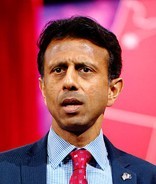 Gage Skidmore
Gage Skidmore Bobby Jindal
Who is he? A former Rhodes Scholar, he’s the outgoing governor of Louisiana. He previously served in the U.S. House.
Is he running? Yes. He kicked off his campaign on June 24.
Who wants him to run? It’s hard to say. Jindal has assiduously courted conservative Christians, both with a powerful conversion story (he was raised Hindu but converted to Catholicism in high school) and policies (after other governors reversed course, he charged forward with a religious-freedom law). But he still trails other social conservatives like Ted Cruz and Mike Huckabee.
Can he win the nomination? Probably not. Jindal still lacks traction at the national level, he faces an overcrowded field of social conservatives, and his stewardship of the state of Louisiana has come in for harsh criticism even from staunch fiscal conservatives. It’s hard to see how he gains momentum from here.
What else do we know? In 1994, he wrote an article called “Physical Dimensions of Spiritual Warfare,” in which he described a friend’s apparent exorcism.
Does his website have a good 404 page? Meh. Good joke, but past its expiration date.
 Gage Skidmore
Gage Skidmore Donald Trump
Who is he? The real-estate developer and reality-TV star fired TV personality almost certainly isn’t worth as much as he wants you to think he is.
Is he running? Like, for real? Of course not. He declared on June 16 and, incredibly, he has filed with the FEC, but the question to watch is what happens when he has to file financial disclosures.
Who wants him to run? Jon Stewart; Donald Trump.
Can he win the nomination?

What else do we know? I’m deeply ashamed and upset that I had to fill out this entry.
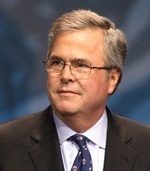 Gage Skidmore
Gage Skidmore Jeb Bush
Who is he? The brother and son of presidents, he served two terms as governor of Florida, from 1999 to 2007.
Is he running? Yes, as of June 15.
Who wants him to run? Establishment Republicans; George W. Bush; major Wall Street donors.
Can he win the nomination? No one really knows. Since jumping into the race, he has continued to poll well and raise lots of money. He seems like a lock to rack up all-important endorsements from top Republicans. But predictions that he would quickly come to dominate the field have not come to pass, and while many analysts predicted that his moderate record would cause trouble in Iowa and with grassroots activists, that problem seems to be deeper than expected. His poll numbers are probably helped by his name, which is a double-edged sword.
What else do we know? Since Bush's surprise announcement, he has tended to stay fairly quiet, delivering some big speeches and hitting fundraisers, but not making a great number of trips to Iowa or New Hampshire.
Does his website have a good 404 page? Yes—y en español también.
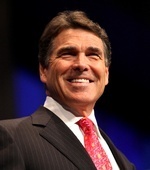 Gage Skidmore
Gage Skidmore Rick Perry
Who is he? George W. Bush’s successor as governor of Texas, he entered the 2012 race with high expectations, but sputtered out quickly. He left office in 2014 as the Lone Star State’s longest-serving governor.
Is he running? Yes. He announced on June 4.
Who wants him to run? Small-government conservatives; Texans; immigration hardliners; foreign-policy hawks. Noah Rothman makes a case here. (Perry's top backer four years ago, non-relative Bob Perry, died in 2013.)
Can he win the nomination? Maybe, but who knows? Perry and his backers insist 2016 Perry will be the straight shooter who oversaw the so-called Texas miracle, not the meandering, spacey Perry of 2012. We'll see. Perry has also made a point of quietly spending lots of time in Iowa, a strategy he didn’t use in 2012—but which Rick Santorum used very successfully.
Does his website have a good 404 page? That depends. Is this an “oops” joke? If so, yes.
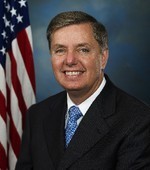 Wikimedia
Wikimedia Lindsey Graham
Who is he? A senator from South Carolina, he’s John McCain’s closest ally in the small caucus of Republicans who are moderate on many issues but very hawkish on foreign policy.
Is he running? He sure is. Graham kicked off the campaign June 1.
Who wants him to run? John McCain, naturally. Senator Kelly Ayotte, possibly. Joe Lieberman, maybe?
Can he win the nomination? Not really. The South Carolina senator seems to be running in large part to make sure there’s a credible, hawkish voice in the primary. It seems like Graham started his campaign almost as a lark but has started to enjoy the ride, plus he’s shown he’s a great performer on the stump. Molly Ball explores his chances at greater length here.
What else do we know? Graham promises to have a rotating first lady if he wins. We nominate Lana del Ray.
 Michael Vadon
Michael Vadon George Pataki
Who is he? Pataki ousted incumbent Mario Cuomo in 1994 and served three terms as governor of New York.
Is he running? Yes. He announced May 28.
Who wants him to run? It's not clear. Establishment Northeastern Republicans once held significant sway over the party, but those days have long since passed.
Can he win the nomination? No. As my colleague Russell Berman previously noted, Pataki is one of the longest of the long-shot GOP candidates. He has touted his leadership on 9/11, when he served as governor, but so did former New York City Mayor Rudy Giuliani. He was also a successful conservative governor in a deep-blue Northeastern state, but so was former Massachusetts Governor Mitt Romney. He seems to be socially liberal enough to alienate primary voters, but not enough to capture Democrats.
Does his website have a good 404 page? No.
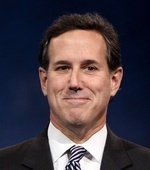 Gage Skidmore
Gage Skidmore Rick Santorum
Who is he? Santorum represented Pennsylvania in the Senate from 1995 until his defeat in 2006. He was the runner-up for the GOP nomination in 2012.
Is he running? Yes, with a formal announcement on May 27.
Who wants him to run? Social conservatives. The former Pennsylvania senator didn't have an obvious constituency in 2012, yet he still went a long way, and Foster Friess, who bankrolled much of Santorum's campaign then, is ready for another round.
Can he win the nomination? It's tough to imagine. Santorum himself said his chances would hinge on avoiding saying "crazy stuff that doesn't have anything to do with anything." For now, his poll numbers remain in the basement.
Does his website have a good 404 page? No.
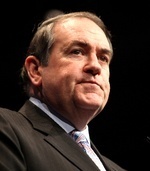 Gage Skidmore
Gage Skidmore Mike Huckabee
Who is he? An ordained preacher, former governor of Arkansas, and Fox News host, he ran a strong campaign in 2008, finishing third, but sat out 2012.
Is he running? Yes. He kicked off the campaign May 5.
Who wants him to run? Social conservatives; evangelical Christians.
Can he win the nomination? Huckabee's struggle will be to prove that he's still relevant. Since he last ran in 2008, a new breed of social conservatives has come in, and he'll have to compete with candidates like Ted Cruz. His brand of moral crusading feels a bit out of date in an era of widespread gay marriage—not least when he curiously chose to attack Beyoncé. (His statements in support of Josh Duggar have also earned him criticism and quizzical reaction.) He faces fire from strict anti-tax conservative groups for tax hikes while he was governor. And fundraising has always been his weak suit. But Huckabee's combination of affable demeanor and strong conservatism resonates with voters.
Does his website have a good 404 page? It’s pretty good.
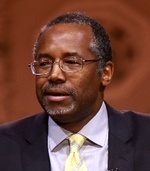 Gage Skidmore
Gage Skidmore Ben Carson
Who is he? A celebrated former head of pediatric neurosurgery at Johns Hopkins, Carson became a conservative folk hero after a broadside against Obamacare at the 2013 National Prayer Breakfast.
Is he running? Yes, after a May 4 announcement.
Who wants him to run? Grassroots conservatives, who have boosted him up near the top of polls, even as Republican insiders cringe. Carson has an incredibly appealing personal story—a voyage from poverty to pathbreaking neurosurgery—and none of the taint of politics.
Can he win the nomination? Almost certainly not. Carson's politics are conservative on some issues, but so eclectic as to be nearly incoherent overall. He's never run a political campaign, and has a tendency to do things like compare ISIS to the Founding Fathers. Despite initially building a formidable organization, he’s struggled to keep it together, with a rash of top staffers defecting.
Does his website have a good 404 page? No.
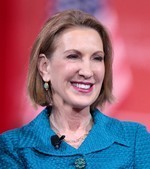 Gage Skidmore
Gage Skidmore Carly Fiorina
Who is she? Fiorina rose through the ranks to become CEO of Hewlett-Packard from 1999 to 2005, before being ousted in an acrimonious struggle. She advised John McCain’s 2008 presidential campaign and unsuccessfully challenged Senator Barbara Boxer of California in 2010.
Is she running? Yes, as of a May 4 announcement.
Who wants her to run? It isn’t clear what Fiorina’s constituency is. She’s a former CEO of Hewlett-Packard, but there are other business-friendly candidates in the race, all of whom have more electoral experience.
Can she win the nomination? Almost certainly not. Fiorina’s only previously political experience was a failed Senate campaign against Barbara Boxer in 2010. She has mostly been serving the role of harasser in the race so far, stirring up the news with slams on environmentalists for causing droughts (your guess is as good as mine), Obama for backing net neutrality, and Apple’s Tim Cook for speaking out on Indiana’s Religious Freedom Restoration Act. Mainly, though, she has strongly criticized Hillary Clinton, and some Republican strategists like the optics of having a woman to criticize Clinton so as to sidestep charges of sexism. Fiorina seems to be wowing voters in Iowa, but that hasn’t translated into national support—yet.
What else do we know? Fiorina's 2010 Senate race produced two of the most entertaining and wacky political ads ever, "Demon Sheep" and the nearly eight-minute epic commonly known as "The Boxer Blimp."
Does her website have a good 404 page? No.
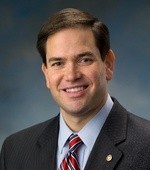 Wikimedia
Wikimedia Marco Rubio
Who is he? A second-generation Cuban-American and former speaker of the Florida House, Rubio was catapulted to national fame in the 2010 Senate election, after he unexpected upset Governor Charlie Crist to win the GOP nomination.
Is he running? Yes—he announced on April 13.
Who wants him to run? Rubio enjoys establishment support, and has sought to position himself as the candidate of an interventionist foreign policy.
Could he win the nomination? Charles Krauthammer pegs him as the Republican frontrunner. His best hope seems to be to emerge as a consensus candidate who can appeal to social conservatives and hawks, and he's even sounded some libertarian notes of late. He's well-liked by Republicans, and has surged forward since announcing, but he needs to move up from second choice to first choice for more of them. Rubio seems to scare Democrats more than any other candidate, too.
Does his website have a good 404 page? It’s decent.
 Wikimedia
Wikimedia Rand Paul
Who is he? An ophthalmologist and son of libertarian icon Ron Paul, he rode the 2010 Republican wave to the Senate, representing Kentucky.
Is he running? Yes, as of April 7.
Who wants him to run? Ron Paul fans; Tea Partiers; libertarians; civil libertarians; non-interventionist Republicans.
Can he win the nomination? That depends who you ask. The Kentucky senator would be an unorthodox pick, with many positions outside his party's mainstream. He's relatively permissive on drugs, passionate about civil liberties, and adamantly in favor of restraint on foreign policy. But Paul has worked hard to firm up establishment ties since reaching the Senate, and he has recently worked to paper over his differences with GOP’s hawkish wing, calling for a declaration of war against ISIS and generally saber-rattling. He is positioning himself as a candidate with crossover appeal in the general election, and his announcement email mocked the idea that only an establishment candidate can win a general election.
What else do we know? One of Paul's greatest strengths is the base bequeathed to him by his father, three-time presidential candidate and former Representative Ron Paul. But as The Washington Post has reported, his father is also Senator Paul's biggest headache.
Does his website have a good 404 page? No.
 Wikimedia
Wikimedia Ted Cruz
Who is he? Cruz served as deputy assistant attorney general in the George W. Bush administration and was appointed Texas solicitor general in 2003. In 2012, he ran an insurgent campaign to beat a heavily favored establishment Republican for Senate.
Is he running? Yes. He launched his campaign March 23 at Liberty University in Virginia.
Who wants him to run? Hardcore conservatives; Tea Partiers who worry that Rand Paul is too dovish on foreign policy; social conservatives.
Can he win the nomination? Though his announcement gave Cruz both a monetary and visibility boost, he still starts with some serious weaknesses. Much of Cruz's appeal to his supporters—his outspoken stances and his willingness to thumb his nose at his own party—also imperil him in a primary or general election, and he's sometimes been is own worst enemy when it comes to strategy. But Cruz is familiar with running and winning as an underdog.
Does his website have a good 404 page? No.
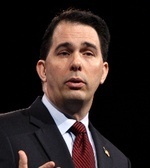 Gage Skidmore
Gage Skidmore Scott Walker
Who is he? Elected governor of Wisconsin in 2010, Walker earned conservative love and liberal hate for his anti-union policies. In 2013, he defeated a recall effort, and he won reelection the following year.
Is he running? Almost certainly.
Who wants him to run? Walker's record as governor of Wisconsin excites many Republicans. He's got a solid résumé as a small-government conservative. His social-conservative credentials are also strong, but without the culture-warrior baggage that sometimes brings. And Walker has won three difficult elections in a blue-ish state.
Can he win the nomination? No one knows. For all his strengths, Walker has never run a national campaign and isn't exactly Mr. Personality. But Jeb Bush's emergence seems to have helped Walker, propelling him to the front of the pack as a more conservative alternative to Bush. He's now solidly in the top tier of candidates.
When will he announce? Likely on July 13.
What else do we know? Barack Obama took a shot on April 7 at Walker for his criticism of a nuclear-deal framework with Iran. That's a sign that he's becoming a power player, and sniping from the White House is only likely to elevate Walker's standing with Republicans. Good news, bad news: Walker has a geographic advantage in his proximity to Iowa, but a potential biological disadvantage from his allergy to dogs.
 Gage Skidmore
Gage Skidmore Sarah Palin
Who is she? If you have to ask now, you must not have been around in 2008. That’s when John McCain selected the then-unknown Alaska governor as his running mate. After the ticket lost, she resigned her term early and became a television personality.
Is she running? A bizarre speech in January made a compelling case both ways.
Who wants her to run? Palin still has diehard grassroots fans, but there are fewer than ever.
Can she win the nomination? No.
When will she announce? It doesn't matter.
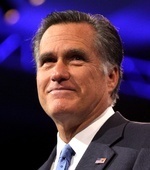 Gage Skidmore
Gage Skidmore Mitt Romney
Who is he? The Republican nominee in 2012 was also governor of Massachusetts and a successful businessman.
Is he running? Nah. He announced in late January that he would step aside.
Who wanted him to run? Former staffers; prominent Mormons; Hillary Clinton's team. Romney polled well, but it's hard to tell what his base would have been. Republican voters weren't exactly ecstatic about him in 2012, and that was before he ran a listless, unsuccessful campaign. Party leaders and past donors were skeptical at best of a third try.
Could he have won the nomination? He proved the answer was yes, but it didn't seem likely to happen again.
 Gage Skidmore John Bolton
Gage Skidmore John Bolton Who is he? A strident critic of the UN and leading hawk, he was George W. Bush’s ambassador to the UN for 17 months.
Is he running? Nope. After announcing his announcement, in the style of the big-time candidates, he posted on Facebook that he wasn’t running.
Who wanted him to run? Even among super-hawks, he didn’t seem to be a popular pick, likely because he had no political experience.
Could he have won the nomination? They say anything is possible in politics, but this would test the rule. A likelier outcome could be a plum foreign-policy role in a hawkish GOP presidency.
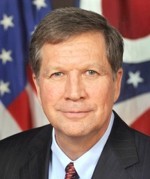 Wikimedia
Wikimedia John Kasich
Who is he? The current Ohio governor ran once before, in 2000, after a stint as Republican budget guru in the House. Between then and his election in 2010, he worked at Lehman Brothers. Molly Ball wrote the definitive profile in April.
Is he running? Almost certainly. He has visited early states, laid out ideas, and established a PAC.
Who wants him to run? Kasich’s pitch: He’s got better fiscal-conservative bona fides than any other candidate in the race, he’s proven he can win blue-collar voters, and he’s won twice in a crucial swing state. While his polling isn’t stellar, he still leads Graham, Fiorina, and Jindal.
Can he win the nomination? As Ball noted, Kasich seems in some ways perfectly suited to this race; in other ways, his insistent anti-charisma makes it hard to imagine him winning, and his attitude is amusingly blasé: “If they like it, great. If they don’t like it, I’ll play more golf.” He could be hurt by his embrace of Medicaid expansion under Obamacare, a move he had to circumvent the Republican-led General Assembly to make.
When will he announce? July 21 at the Ohio State University.
What else do we know? He doesn’t own a smartphone, and seldom uses a computer. Maybe he can be friends with Lindsey Graham—the old way, via U.S. Mail.
Others Still in the Mix:
Bob Ehrlich, Peter King, Harold Stassen, Jim Gilmore









How America's Workforce Has Changed Since 1977

As long as you don’t look too far into it, Thursday’s June jobs report looks like good news: The economy added 223,000 jobs, close to expectations, and the unemployment rate fell again, to 5.3 percent. So far, so good—still a slower recovery than anyone might like, but a recovery nonetheless.
The more concerning signs are hidden beneath the surface. Some people have been sounding the alarm about labor-participation rates for years now—Republicans tried, mostly unsuccessfully, to make them an issue in the 2012 election. But as several analysts have pointed out, the June rate of 62.6 percent is the lowest since October of 1977. The decline is part of a long-term trend, as this graph shows:
Workforce Participation, 1945-Present
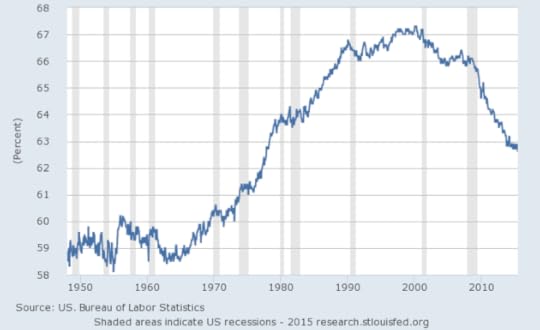 FRED
FRED You can watch the status of women in the workplace change over that arc—as more and more women enter the workforce, the amount climbs and climbs. But overall participation has been declining since the tech bubble burst around 2000.
So what exactly did the United States look like in October 1977, the last time the labor-participation rate was this low? Obviously the most important question is what Americans were listening to. (The month’s top songs were Debby Boone’s “You Light Up My Life” and—seriously—Meco’s “
The Gender Politics of Magic Mike XXL

Spencer Kornhaber: Magic Mike XXL offers a hint about its politics—yes, it has politics—during the first and perhaps only real moment of conflict in the entire film. It happens when Channing Tatum’s Mike suggests to his roadstripping buddies that they retire their sexy-fireman routine and come up with something new. After some resistance, and under the influence of drugs, Joe Manganiello’s Big Dick Richie relents, and starts babbling out a grand plan for a bold, fresh set piece.
His idea: a striptease … as a wedding ceremony.
Related Story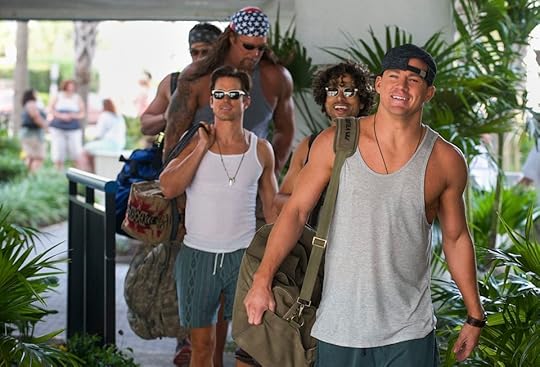
Magic Mike XXL: This Time, It Really Is for the Ladies
Before proceeding, a word about looking for deeper meaning here. Yes, XXL is a skintastic sequel with a plot as slight as Donald Glover in a Hugh Hefner robe, designed to cool down 4th of July audiences just like ice-cream toppings do to Adam Rodriguez’s abs at the film’s climax. But it’s also groundbreaking. Between the Mike franchise and 50 Shades of Grey, we’re watching the formation of a would-be-blockbuster genre, one that celebrates and profits from the sexual appetites of people other than straight men. XXL’s big male-entertainer convention may well turn into a source of storytelling conventions once Hollywood’s imitation machine revs all the way up.
So it’s of note that stripperly innovation in XXL involves the ultimate symbol of traditional gender relations and romantic commitment. When Richie performs the wedding routine toward the end of the film, the actual nuptials segment is sweet and chaste; after the altar, though, he straps his fake bride into a sex swing and starts treating her like a jungle gym. This is in line with the film’s depiction of male entertainers as Cary Grant-level gentlemen when their shirts are on, and Christian Greys trained by Cirque du Soleil when they’re off. I’ve seen at least one critic refer to XXL’s gyration scenes as “rapey,” and there’s certainly merit to the discussing how consensual touching works in the land of lap dances. But almost without fail, the film focuses on giving women what they want, and many of the women on screen are paying to be charmed and then respectfully faux-dominated by a hunk.
What do the guys want? To get married, of course. The first Magic Mike loaded up its male entertainers with career anxieties, drug addictions, and social disapproval, but this time out the only angst comes from a very specific kind of girl problem. Mike—spoiler—returns to stripping after his girlfriend rejects his engagement ring. Matt Bomer’s Ken searches for contentment in singledom because his gal couldn’t pull off monogamy. Kevin Nash’s Tarzan confesses that he’d trade his years of promiscuity for one true soul mate. And in the film’s filthiest reclamation of fairy-tale monogamy, Rich (timidly, respectfully) quests for a woman who appreciates the feature that gave him his nickname, referring to this mythical mate as “the glass slipper.”
These pointedly macho guys seem blissfully free from anxiety about being labelled as feminine.One thing that’s not traditional about the guys is their utter lack of gay panic. Early on during their trip, they stop in at a drag show and start vogue-ing on stage, having as much fun as anyone at a Pride parade. It makes sense that guys who regularly bro out while in chaps would be secure in their sexuality, but these pointedly macho guys seem exceptionally, blissfully free from anxiety about being labeled as feminine. When Ken punches Mike to settle a beef, it’s portrayed as stupid and pointless, and for the rest of the movie, the guys talk through their problems. They also talk—in meaningful and hilarious ways, sometimes driven by attraction but sometimes not—with women, whether it’s Mike bantering with Amber Heard’s Zoe or all the guys swapping life stories with Andie MacDowell’s Nancy and friends. It’s much-needed evangelism: Behold, men can still joke around, have sex, and make money once we’ve smashed the patriarchy!
As for the women: Jada Pinkett Smith’s Rome as empress of male entertainers and Zoe as cagey stripper/photographer certainly made for refreshing examples of strong female characters. On the other hand, none of them felt as real or human to me as the guys did. Rome was inspiring but almost seemed fiercer-than-life; Zoe felt a bit like a melancholic pixie dream girl, wielding her camera and standoffishness mainly for Mike’s fascination. Maybe those are my own biases showing, though. What do you two think?
Megan Garber: What I mostly think is that “roadstripping” should be entered into the OED immediately. But I agree: I was fascinated by how much gender politicking—both subtle and egregious—was packed into those tiny little man-thongs. While the first Magic Mike struck me as a commentary on the economy in the guise of a movie about strippers—the plot revolved around the fact that these “male entertainers” were all, in their way, frustrated entrepreneurs—this one struck me as a commentary about feminism … in the guise of a movie about strippers. The whole thing was fixated, to an almost comical degree, on ideas and assumptions about what women want. Which I mostly loved. As you point out, Spencer, it means that we’re moving beyond the tired desiric default of the straight, male dude. Which: Progress! The kind of caveated progress that’s so often on display in the products of Hollywood, but still!
What I didn't love, however, was that a lot of these (relatively) progressive ideas manifested in MMXXL not just as What Women Want, but as What Women Want According to Dudes. Marriage! Being called “queens” and “goddesses”! Being danced for! Being grinded (ground?) upon! Being poetried about! Being sung to! Being the objects of sentences with passive constructions, in which men are the implied subjects! It’s telling, I think, that the screenplay of MMXXL was written by Tatum and Reid Carolin (the screenwriter for the first Magic Mike); the whole thing, despite its many (many, many) feministic delights, also has a whiff of mansplaining to it. It reminded me just a tad of that wonderfully terrible Mel Gibson movie, What Women Want—only with an inverted moral: Instead of making fun of men who assume that “what do women want?” is, monolithically, a reasonable question to ask, MMXXL congratulates them for doing the asking at all. And then it concludes that the answer must involve being crooned at by Donald Glover.
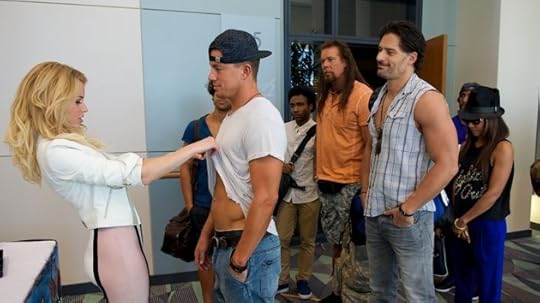 Warner Bros.
Warner Bros. Along those lines, I totally agree, Spencer, that the female characters felt much less fully realized than the male here. Rome (and I loved Pinkett Smith in the role) took on the Dallas-ian mantle of the larger-than-life performer, all fierceness and fire and force; that meant, though, that we got almost nothing about who she was as a person. And that weird kiss she had with Elizabeth Banks (our eagle-eyed Chris Orr noticed that Banks’ character’s name is, natch, Paris) seemed to have been included in the proceedings paaaartly for purposes of character development, but mostly for the service of the straight guys in the audience who might be dragged to this movie by their wives/girlfriends. Gorgeous women making out, for no reason but male pleasure! How innovative.
And while I agree that Zoe definitely had a pixie dreamgirliness about her, one thing I did appreciate about her was the fact that, even though we were told repeatedly that she, too, was a stripper … we never saw her take her clothes off. Given the way she ended up participating in the (delightfully uncreatively named) 2015 Annual Stripper Convention, you could see her as being, like so many other women in this movie, simply a kind of object; you could also see her “performance” in that show, though, as the film’s acquiescence to her wishes. What This Particular Woman Wants is to be seen as something other than a stripper, and the movie fulfills that desire by making her, onstage, the passive party. Which: Progress! Sort of!
One final thought about the 2015 Annual Stripper Convention: I loved the way it played—cleverly, teasingly—with cliches and novelties. Here is yet another Film That Leads Up to a Climactic Final Performance, in the proud tradition of Pitch Perfect and Bring It On and pretty much every sports movie ever made. And MMXXL winks at its own place in that pantheon through the expected rehearsal montages, scenes of costume-making and prop-building, hints at the acts that will come, etc. (Even the setting for the performance—I cannot fully express how much I love “2015 Annual Stripper Convention,” especially as it was displayed on that sad hotel billboard in Myrtle Beach—pokes fun, with its winking blandness, at the stereotypic baggage the film is dragging with it as it speeds along the I-75 corridor.)
That said, though: MMXXL, leading up to those climactic final scenes, also leaves space for mystery and surprise. It keeps you guessing. The best stripping acts (at least according to Showgirls and that Demi Moore movie from the mid-’90s) involve taking audience expectations and either thwarting or delaying their gratification—the strip “tease,” and all that. They involve building suspense, so that audiences both know, and also have no idea, what’s in store for them. In that sense, and in the best sense, MMXXL is itself just one big, ridiculous, and really fun strip show.
Sophie Gilbert: Aside from the question of whether a movie about male strippers that’s written and directed by men and stars men in all the primary roles can be a positive thing (it’s certainly no rarity in Hollywood), here’s the thing about MMXXL: I enjoyed every second of it. It’s a movie that celebrates the fact that it doesn’t want to make you think—there’s nothing to pick apart in the car ride on the way home apart from Tito’s curious pairing of kiwi and ginger in his artisanal fro-yo, or what the hell Nancy’s husband did to obligate that he leave her his Bentley and collection of Chateau Margaux, or whether it’s actually a good idea for Mike to carry around a rejected engagement ring in his wallet.
In a cultural landscape where we’re continually obliged to dissect things by going over them ad infinitum, it’s pretty refreshing to have a movie that’s so seemingly free of nuance. There are bros. The bros take their clothes off. This time, however, they seem truly happy to be doing so, and in fact, generally affirmed by both the female attention and the opportunity to make women feel like, yes, queens. The entire posse seems to have had some kind of spiritual Road to Damascus somewhere between the first film and MMXXL—Ken, free of all negative energy and a stage-three reiki healer, is representative of how the angst and darkness from Magic Mike has been thoroughly cleansed. Maybe it’s the smudge sticks, maybe it’s the molly, maybe it’s the fact that Alex Pettyfer has left the building. But the troupe appeared to be genuinely happy with themselves and their testosterone-charged road trip, which perhaps means they’re better able to bestow that happiness upon their target audiences.
When it comes to giving women what they want, which you both mentioned, the kiss between Rome and Paris was perhaps the only off note in the whole movie. Otherwise, it’s a narrative structured entirely around the objectification of men and the veneration of women, whatever their age or body type. In the sense that almost all the female characters have money to dole out to men (the aforementioned Bentley, the many, many, many, many dollar bills cascading all over the scenery), it’s a reversal of the typical Cinderella story: Here are good-looking dolts being rewarded for their charms. But what makes Mike and Richie and Ken so appealing isn’t just their looks, it’s the fact that they focus so intensely on how to make women happy. (“My God is a woman,” as Mike puts it, in simple terms.) In Ken’s case, that means telling a married woman that she’s enormously desirable and deserves to be made love to with the lights on. In Mike’s and Richie’s, it’s simply making people smile. If the film were just about greased-up Adonises showing off their abs, it wouldn’t be half as affirming, but the sense throughout that female contentment and pleasure is the ultimate goal makes it infinitely more engaging.
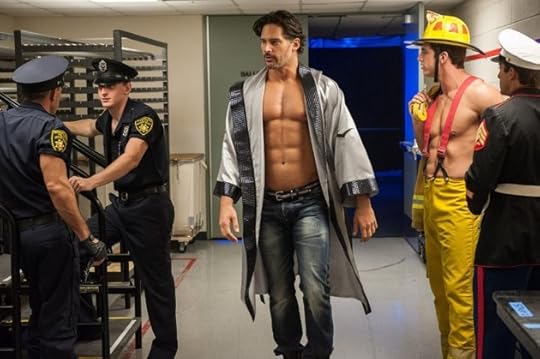 Warner Bros.
Warner Bros. In this sense, like you mentioned Megan, MMXXL seems to theorize that stripping is a fun and fulfilling career for men and a miserable one for women (presumably why Zoe wants to quit) because women are simply better at doing the objectifying—they can appreciate men as bodies and souls together rather than pieces of meat. Perhaps this is why Mike helps his friends get more creatively involved with their routines, so that they can express their personalities through their art and feel less like generic firemen/policemen/rent-a-hunks. One of my favorite scenes in the movie was when Richie walked through the convention center looking askance at all the boringly costumed strippers hanging around. Why be a fireman when you can be a painter? Or a groom? Or an incredibly filthy ice-cream vendor? Or a singer? Let’s at least appreciate how much the routines subvert traditional male career stereotypes and go straight for the humanities instead.
All this is to say that, yes, I think a movie about male strippers can be empowering for women, but not just because they’re getting the chance to leer at oily men in thongs and rain their hard-earned cash upon them. Instead, MMXXL feels like a movie that cares about the hopes and dreams of all its characters, and wants only to help them realize them, via simulated humping, strobe lights, and a woman boss in a pantsuit (possibly an endorsement of Hillary 2016?). It’s a quirky path to choose, sure, but it’s a ton of fun, so I’ll take it.









The Philippines Suffers Its 14th Disaster at Sea Since 2000

Just before noon on Thursday, a motorized outrigger canoe carrying 189 people set off from Ormoc City, a town in the Philippines’ Leyte Province. Beset by inclement weather and high winds, the MBCA Kim-Nirvana capsized just 650 feet from shore, causing passengers to scramble to safety. One-hundred twenty-seven managed to survive the incident, while at least 36 have died. Another 26 remain missing. The incident was the world’s most fatal maritime disaster since February, when 68 died after a passenger ferry sank in Bangladesh.
A tropical country of nearly 100 million situated across more than 7,000 islands, the Philippines is particularly susceptible to disaster at sea. Thursday’s capsizing was the 14th major ferry accident in the country since 2000 and the deadliest since 2008, when the sinking of the Don Dexter Kathleen claimed 44 lives. In 1987, a collision between the Dona Paz, a passenger ferry, and an oil tanker resulted in the death of over 4,000 people—the worst peacetime maritime tragedy in history.
Stormy weather often plays a large part in maritime disasters. But many Philippine ferries are also old and poorly maintained, and overcrowding is common. According to the Philippine Red Cross, the majority of the passengers on the MBCA Kim-Nirvana were of modest means: farmers, fishermen, or “ordinary businessmen.” More affluent Filipinos can afford to travel by sturdier ships or airplane.
Investigators have not yet determined an official cause of the capsizing. National attention remains focused on search and rescue operations. Armand Balilo, a spokesperson for the Philippine Coast Guard, said that the windy conditions contributed to the disaster, according to Reuters. But, he added, “the sea condition was manageable.”









A Ferry Disaster in the Philippines

Just before noon on Thursday, a motorized outrigger canoe carrying 189 people set off from Ormoc City, a town in the Philippines’ Leyte Province. Beset by inclement weather and high winds, the MBCA Kim-Nirvana capsized just 650 feet from shore, causing passengers to scramble to safety. One-hundred twenty-seven managed to survive the incident, while at least 36 have died. Another 26 remain missing. The incident was the world’s most fatal maritime disaster since February, when 68 died after a passenger ferry sank in Bangladesh.
A tropical country of nearly 100 million situated across more than 7,000 islands, the Philippines is particularly susceptible to disaster at sea. Thursday’s capsizing was the 14th major ferry accident in the country since 2000 and the deadliest since 2008, when the sinking of the Don Dexter Kathleen claimed 44 lives. In 1987, a collision between the Dona Paz, a passenger ferry, and an oil tanker resulted in the death of over 4,000 people—the worst peacetime maritime tragedy in history.
Stormy weather often plays a large part in maritime disasters. But many Philippine ferries are also old and poorly maintained, and overcrowding is common. According to the Philippine Red Cross, the majority of the passengers on the MBCA Kim-Nirvana were of modest means: farmers, fishermen, or “ordinary businessmen.” More affluent Filipinos can afford to travel by sturdier ships or airplane.
Investigators have not yet determined an official cause of the capsizing. National attention remains focused on search and rescue operations. Armand Balilo, a spokesperson for the Philippine Coast Guard, said that the windy conditions contributed to the disaster, according to Reuters. But, he added, “the sea condition was manageable.”









Atlantic Monthly Contributors's Blog
- Atlantic Monthly Contributors's profile
- 1 follower



